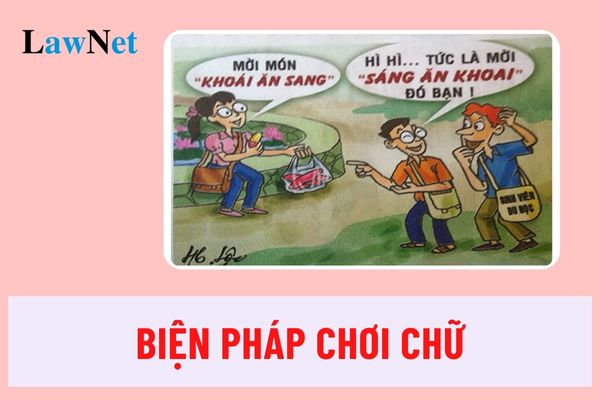What is the Pun Technique according to the Literature curriculum in Vietnam? What are effects and examples of the Pun Technique?
What is the Pun Technique according to the Literature curriculum in Vietnam? What are effects and examples of the Pun Technique?
Pun technique is a distinct rhetorical technique often used in literature, poetry, and everyday communication. When using this technique, the writer or speaker takes advantage of the polysemy, homophony, and near-homophony of words to create unique artistic effects, surprising and delighting the reader or listener.
Effects of Pun Rhetorical Techniques:
- Increasing humor and wittiness: Pun creates witty, humorous utterances, reducing tension and creating a joyful atmosphere.
- Making sentences and verses more vivid and engaging: Thanks to the surprising and unique use of words, Pun helps sentences and verses become more vivid, memorable, and strongly impressive.
- Creating multiple layers of meaning: A sentence or verse using Pun often carries multiple layers of meaning, stimulating the curiosity and creativity of the reader or listener.
- Emphasizing ideas: Pun subtly and effectively emphasizes certain ideas or viewpoints.
Common Types of Pun
- Pun based on homophony: Using words with identical sounds but different meanings.
- Pun based on near-homophony: Using words with nearly identical sounds.
- Pun based on alliteration: Repeating a syllable or a group of syllables.
- Pun based on spoonerism: Reversing the order of syllables within a word.
- Pun based on antonyms and synonyms: Using antonyms or synonyms to create opposition or similarity.
Examples of Pun in Literature
Folk sayings, proverbs:
- Pun based on homophony:
"Thầy bói xem quẻ nói rằng: Lợi thì có lợi, nhưng răng không còn." (Implying the elderly should not remarry)
"Con cá đối bỏ trong cối đá, Con mèo cái nằm trên mái kèo." (Pun with the word "female")
- Pun based on near-homophony:
"Tốt gỗ hơn tốt nước sơn"
"Đi một ngày đàng học một sàng khôn"
- Pun based on spoonerism:
"Cô gái Củ Chi chỉ cu hỏi củ chi; Chàng trai Hòn Đất hất đòn trúng hòn đất."
- Pun based on opposition:
"Đêm tháng năm chưa nằm đã sáng, Ngày tháng mười chưa cười đã tối."
- Pun based on alliteration:
"Rừng xanh hoa lá, chim ca tiếng hót"
Poetry:
"Bóng bẩy áo quần non tơ/ Mắt như sao sáng, mũi như hồ lô" (Pun with the word "hồ lô" to describe Thuy Kieu's beauty)
"Mênh mông muôn mẫu một màu mưa/ Mỏi mắt miên man mãi mịt mờ" (Pun with words starting with "m")
Prose:
"Cái răng cái tóc là góc con người"
Note: The above content is for reference purposes only.

What is the Pun Technique according to the Literature curriculum in Vietnam? What are effects and examples of the Pun Technique? (Image from the Internet)
What are the contents of Vietnamese Language subject in the Grade 9 curriculum in Vietnam?
Knowledge of the Vietnamese Language for Grade 9 students is stipulated in the sub-section 2 of Section 5 of the Vietnamese Language Curriculum issued with Circular 32/2018/TT-BGDDT as follows:
- Differences in meanings of some easily confused Sino-Vietnamese elements (e.g., "đồng" in "đồng dao", "đồng âm", "đồng minh"; "minh" in "thanh minh", "minh oan", "u minh")
- Classical references and anecdotes (e.g., "The Cowherd and the Weaver Girl", "Tai ong that ma"): characteristics and effects
- Meanings and uses of acronyms for important international organizations (such as UN, UNESCO, UNICEF, WHO, WB, IMF, ASEAN, WTO,...)
- Alteration and expansion of sentence structure (changing the order of sentence components, adding subordinate elements,...): characteristics and effects
- Choosing between simple and compound sentences, types of compound sentences, conjunctions for connecting clauses in compound sentences
- Elliptical and special sentences: characteristics and functions
- Rhetorical techniques of Pun, consonance, and rhyme: characteristics and effects
- Differences between direct and indirect speech; punctuation use in direct and indirect speech
- Text forms and genres
+ Narrative text: storytelling, simulating a read story; storytelling from a comic
+ Expressive text: eight-syllable poem; segment reflecting on an eight-syllable poem
+ Argumentative text: role of thesis, reasoning, and evidence in presenting content in argumentative text; problem-solving argumentative essay; analysis essay of a literary work
+ Informative text: presenting ideas and information in a text; expressive effectiveness of non-verbal means in an informational text; explanatory text on a social phenomenon; explanatory text on a historical site or landmark; advertisements, pamphlets
- A few notes about referencing and citing materials to avoid plagiarism
- Language development: new words and new meanings
- An overview of the history of Vietnamese script: Nom script and national script
- Non-verbal communication means: images, data, charts,...
What are literary materials for Grade 9 Vietnamese Language subject in Vietnam?
Based on sub-section 2 of Section 5 of the Vietnamese Language Curriculum issued with Circular 32/2018/TT-BGDDT, the literary materials for Grade 9 Vietnamese Language subject in Vietnam include:
(1) Literary texts
- Medieval tales, detective stories
- Poetic forms like "song thất lục bát", Nôm narrative poems, eight-syllable poetry
- Tragedy
(2) Argumentative texts
- Social arguments
- Literary criticism
(3) Informative texts
- Texts introducing a scenic spot or historical relic
- Interviews

